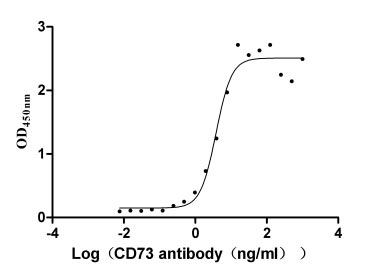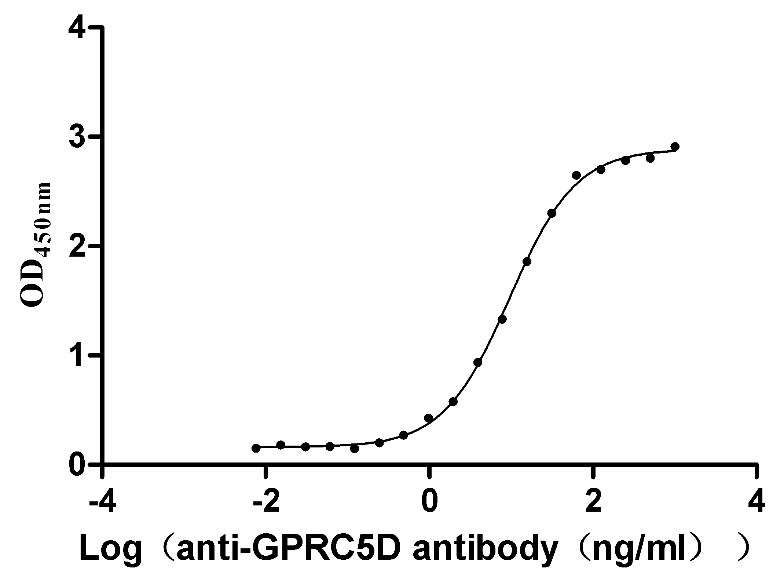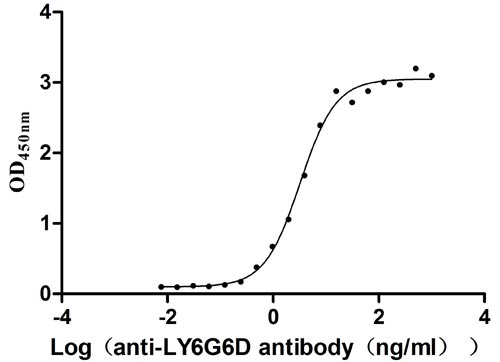Recombinant Mouse Mitochondrial uncoupling protein 3 (Ucp3), partial
-
中文名称:小鼠Ucp3重组蛋白
-
货号:CSB-YP025556MO1
-
规格:
-
来源:Yeast
-
其他:
-
中文名称:小鼠Ucp3重组蛋白
-
货号:CSB-EP025556MO1
-
规格:
-
来源:E.coli
-
其他:
-
中文名称:小鼠Ucp3重组蛋白
-
货号:CSB-EP025556MO1-B
-
规格:
-
来源:E.coli
-
共轭:Avi-tag Biotinylated
E. coli biotin ligase (BirA) is highly specific in covalently attaching biotin to the 15 amino acid AviTag peptide. This recombinant protein was biotinylated in vivo by AviTag-BirA technology, which method is BriA catalyzes amide linkage between the biotin and the specific lysine of the AviTag.
-
其他:
-
中文名称:小鼠Ucp3重组蛋白
-
货号:CSB-BP025556MO1
-
规格:
-
来源:Baculovirus
-
其他:
-
中文名称:小鼠Ucp3重组蛋白
-
货号:CSB-MP025556MO1
-
规格:
-
来源:Mammalian cell
-
其他:
产品详情
-
纯度:>85% (SDS-PAGE)
-
基因名:Ucp3
-
Uniprot No.:
-
别名:Ucp3; Slc25a9; Mitochondrial uncoupling protein 3; UCP 3; Solute carrier family 25 member 9
-
种属:Mus musculus (Mouse)
-
蛋白长度:Partial
-
蛋白标签:Tag type will be determined during the manufacturing process.
The tag type will be determined during production process. If you have specified tag type, please tell us and we will develop the specified tag preferentially. -
产品提供形式:Lyophilized powder
Note: We will preferentially ship the format that we have in stock, however, if you have any special requirement for the format, please remark your requirement when placing the order, we will prepare according to your demand. -
复溶:We recommend that this vial be briefly centrifuged prior to opening to bring the contents to the bottom. Please reconstitute protein in deionized sterile water to a concentration of 0.1-1.0 mg/mL.We recommend to add 5-50% of glycerol (final concentration) and aliquot for long-term storage at -20℃/-80℃. Our default final concentration of glycerol is 50%. Customers could use it as reference.
-
储存条件:Store at -20°C/-80°C upon receipt, aliquoting is necessary for mutiple use. Avoid repeated freeze-thaw cycles.
-
保质期:The shelf life is related to many factors, storage state, buffer ingredients, storage temperature and the stability of the protein itself.
Generally, the shelf life of liquid form is 6 months at -20°C/-80°C. The shelf life of lyophilized form is 12 months at -20°C/-80°C. -
货期:Delivery time may differ from different purchasing way or location, please kindly consult your local distributors for specific delivery time.Note: All of our proteins are default shipped with normal blue ice packs, if you request to ship with dry ice, please communicate with us in advance and extra fees will be charged.
-
注意事项:Repeated freezing and thawing is not recommended. Store working aliquots at 4°C for up to one week.
-
Datasheet :Please contact us to get it.
相关产品
靶点详情
-
功能:UCP are mitochondrial transporter proteins that create proton leaks across the inner mitochondrial membrane, thus uncoupling oxidative phosphorylation. As a result, energy is dissipated in the form of heat. May play a role in the modulation of tissue respiratory control. Participates in thermogenesis and energy balance.
-
基因功能参考文献:
- Our findings, focusing on energy balance, provide a mechanistic understanding of the promising effect of early insulin initiation on lipotoxicity. Insulin, by recovering UCP3 activity, alleviated energy surfeit and potentiated AMPK-mediated lipid homeostasis in skeletal muscle cells following exposure to PA and in gastrocnemius of mice fed HFD. PMID: 29039450
- Findings indicate that while heat-induced reduction in uncoupling proteins-3 improves mitochondrial efficiency in vitro, this is not translated to in vivo improvement of exercise economy at 1600 m or 4350 m. PMID: 28174343
- UCP3 can be fully inhibited by all adenine nucleotides tested and IC50 increases with a decrease in PN-phosphorylation. Conserved arginines in the PN-binding pocket are involved in the inhibition of UCP1 and UCP3 to different extents. Fatty acids compete only with ATP bound to UCP3. UCP3 has adapted to fulfill a different role and possibly another transport function in brown adipose tissue, vs highly homologous UCP1. PMID: 29212043
- our study provides evidence that the genetic risk factors for healthy aging differ in males and females, as expected from the differences in the phenotypes associated with healthy aging between the two sexes. It also has implications for how mitochondrial function changes during aging. PMID: 26965008
- The results indicate that mitochondrial UCP3 activity affects metabolism well beyond fatty acid oxidation, regulating biochemical pathways associated with amino acid metabolism and redox status. PMID: 27871066
- Gene expression data revealed that 1, 4 or 8h of hypoxia results in temporal changes in various transcriptional genes regulating mitochondrial function and a time-dependent progressive increase in the expression of the mitochondrial uncoupling protein 3 (UCP-3) with concomitant changes in genes encoding sarcoplasmic reticulum calcium release proteins. PMID: 26549555
- our study supports an essential role for UCP3 in modulating cardiac mCa2+ uptake via regulation of mCa1 single-channel activity. PMID: 27371160
- Intriguingly, ectopic expression of constitutively active estrogen receptor alpha decreased UCP3 level and increased cellular ATP content in differentiated myoblastic C2C12 cells. Overall, the present study suggests that estrogen plays a critical role in the regulation of energy expenditure and exercise endurance in female. PMID: 27983991
- We found increased mRNA expression of PDK4 and UCP3, which are known to be upregulated after exercise and regulated by PGC-1alpha after lactate administration. PMID: 27218871
- suggest that VD3/VDR inhibits weight gain by activating UCP3 in the muscles. PMID: 27473111
- the protective effect of PPARalpha activation against cardiac ischemia-reperfusion injury in terms of the expression of uncoupling protein (UCP), was investigated. PMID: 26770648
- low 4-Hydroxy-2-nonenal (HNE) doses activate Nrf2 in cardiomyocytes and provide the first evidence of Nrf2 binding to the Ucp3 promoter in response to HNE, leading to increased protein expression PMID: 25843654
- The hydrophilic sequences within loop 2, and the matrix-localized hydrophilic domain of UCP3, were necessary for binding to Hax-1 at the C-terminal domain, adjacent to the mitochondrial inner membrane. PMID: 26915802
- UCP3 overexpression limits keratinocyte proliferation and tumorigenesis through inhibition of Akt. PMID: 26310111
- Ischemia/reperfusion also increased UCP3 transcription, indicating potential for greater uncoupling. PMID: 25450611
- Nrf2 promotes survival by enhancing the expression of uncoupling protein 3 under conditions of oxidative stress. PMID: 23597505
- Data indicated that Trim30 and Ucp3 play pivotal roles in energy balance and glucose homeostasis and might be used as genetic markers to represent the stage of obesity during the early and late stages of adipose tissue development, respectively. PMID: 25895476
- In a mice model of permanent coronary occlusion, UCP3 deficiency results in a metabolic shift that favored glycolytic metabolism and increased FDG uptake in remote areas. PMID: 25103673
- These results are consistent with the conclusions that circulating acylcarnitines could be used as a marker of incomplete muscle FAO and that UCP3 is a potential target for the treatment of prevalent metabolic diseases in which muscle FAO is affected. PMID: 23825224
- Our data indicate that ucp3 levels regulate reactive oxygen species levels and cell survival during hypoxia, modulating infarct size in the ischemic heart PMID: 23688674
- UCP3 plays a critical role in cardioprotection against ischemia-reperfusion injury. PMID: 23457013
- Grx2 deactivates UCP3 by glutathionylation. PMID: 23335511
- Studies show that although UCP3 may mediate mitochondrial uncoupling and reduced CE after HF feeding, it does not mediate uncoupling in leptin-deficient states. PMID: 22912419
- STC1 activates a novel anti-oxidant pathway in cardiac myocytes through induction of UCP3 PMID: 22693564
- UCP3 may have a role in the protection of mitochondria against lipid-induced mitochondrial dysfunction, but only after long-term exposure to high-fat PMID: 22115550
- lack of UCP3 had no apparent effect on basal oxygen consumption of thymocytes or splenocytes or on oxygen consumption due to mitochondrial proton leak PMID: 21689632
- examined oxidative stress by quantifying 4-hydroxynonenal protein adducts and protein carbonyls in the mitochondria-but did not observe any protective effect of UCP3 PMID: 21565164
- Deficiency in UCP3 resulted in a metabolic shift that favoured anaerobic glycolytic metabolism, increased glucose uptake and increased sensitivity to oxidative challenge. PMID: 21554247
- The native UCP3 actively lowers the rate of ROS production in isolated energized skeletal muscle mitochondria, and UCP3 can affect ROS production through a membrane potential-independent mechanism. PMID: 20493945
- no evidence for an involvement of UCP3 in basal, fatty-acid- or superoxide-stimulated oxygen consumption or in GDP sensitivity PMID: 20227385
- UCP3 can minimize the induction of the adenine nucleotide translocase-mediated 'energy-wasting' process during Calorie restriction (CR). PMID: 20206124
- UCP3 is involved both in mediating the translocation of lipid hydroperoxide (LOOH) across the mitochondrial inner membrane and in LOOH-dependent mitochondrial uncoupling PMID: 20363757
- UCP3 was degraded in mitochondria isolated from rat skeletal muscle or brown adipose tissue with a half-life of 0.5-4 h and the turnover is proteasome dependent. PMID: 19954423
- excess recovery heat production by isolated muscles from mice overexpressing uncoupling protein-3 PMID: 12096064
- Mitochondria from UCP3-underexpressing mice had higher levels of oxidative damage than wild-type controls, suggesting that UCP3 functions as part of the antioxidant defences of the cell PMID: 12193161
- expression of UCP3 mRNA was dependent on human muscle differentiation PMID: 12351640
- mice deficient in UCP-3 (for 'uncoupling protein-3') have a diminished thermogenic response to the drug MDMA (3,4-methylenedioxymethamphetamine, nicknamed 'ecstasy') and so are protected against this dangerously toxic effect PMID: 14647371
- Using transgsenic mice,an 18-fold increase of UCP3 mRNA can be attained, suggesting that UCP3 has therapeutic potential in the treatment of obesity. PMID: 14673524
- Consistent with increased energy expenditure, C75 treatment caused greater weight loss than pair-fed controls and increased expression of skeletal muscle UCP-3 mRNA. PMID: 15063757
- UCP3 gene transcription is activated by thyroid hormone treatment in vivo, and this activation is mediated by a TRE (thyroid hormone response element) in the proximal promoter region PMID: 15496137
- findings support the hypothesized role for Uncoupling protein 3 in facilitating fatty acid oxidation in muscle PMID: 15814607
- UCP3 modulates reactive oxygen species production in response to an oxidative stress. PMID: 15922330
- UCP3 attenuates endogenous radical production by the mitochondrial electron transport chain at high protonmotive force. PMID: 16084485
- Overexpression of UCP3 gene in mouse myotube cell culture leads to significant activation of different proteolytic systems involved in muscle myofibrillar protein breakdown. These results suggest possible relation involved in muscle wasting during cancer. PMID: 16337086
- upon high-fat feeding, intramuscular triacylglycerol levels were 50% lower in UCP3-/- mice; succinate dehydrogenase activity, and total protein content of the muscle fatty acid transporter FAT/CD36 were similar between UCP3-/- and UCP3+/+ mice. PMID: 16455084
- PPARalpha-dependent regulation is required for appropriate gene regulation of UCP3 PMID: 16857752
- Apelin treatment increased mRNA expression of UCP3 in skeletal muscle. PMID: 17347313
- increasing mitochondrial uncoupling in skeletal muscle may be an excellent therapeutic target for type 2 diabetes mellitus PMID: 17571165
- Induction of Ucp3 suppresses mitochondrial oxidant emission during fatty acid-supported respiration. PMID: 17761668
- SIRT1 acts as a major repressor of ucp3 gene expression in response to glucocorticoids. PMID: 17884810
显示更多
收起更多
-
亚细胞定位:Mitochondrion inner membrane; Multi-pass membrane protein.
-
蛋白家族:Mitochondrial carrier (TC 2.A.29) family
-
数据库链接:
KEGG: mmu:22229
STRING: 10090.ENSMUSP00000032958
UniGene: Mm.6254
Most popular with customers
-
Recombinant Human 5'-nucleotidase (NT5E) (Active)
Express system: Mammalian cell
Species: Homo sapiens (Human)
-
Recombinant Human G-protein coupled receptor family C group 5 member D (GPRC5D)-VLPs (Active)
Express system: Mammalian cell
Species: Homo sapiens (Human)
-
Recombinant Human Cannabinoid receptor 1 (CNR1)-VLPs (Active)
Express system: Mammalian cell
Species: Homo sapiens (Human)
-
Express system: Mammalian cell
Species: Macaca fascicularis (Crab-eating macaque) (Cynomolgus monkey)
-
Recombinant Human Lymphocyte antigen 6 complex locus protein G6d (LY6G6D) (Active)
Express system: Yeast
Species: Homo sapiens (Human)
-
Recombinant Human Trophoblast glycoprotein (TPBG), partial (Active)
Express system: Mammalian cell
Species: Homo sapiens (Human)
-
Recombinant Human Tumor necrosis factor ligand superfamily member 15(TNFSF15) (Active)
Express system: Mammalian cell
Species: Homo sapiens (Human)








-AC1.jpg)










